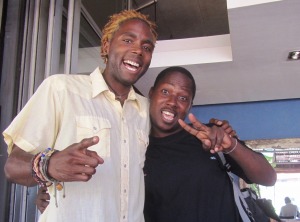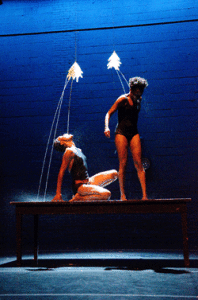My pal Marj has gotten quite ill with laryngitis. I spent part of the morning re-booking her ticket so she could delay her return home until tomorrow and skip a visit to Ethiopia. We were sharing glasses of wine earlier in the week so fingers are crossed that I don’t catch her germs!
I enjoy a final lunch at Lucky Bean with Bamuthi and Hakim Bellamy who has come at Marj’s invitation to learn about the scene here. He is a poet, writer, musician, media maven, youth advocate, and really cool cat. Over lunch he tells us about his adventures yesterday visiting Constitution Hill and Court, getting lost in Hillbrow, one of the toughest neighborhoods downtown, and visiting a super cool library, print shop and media space serving youth.
Bamuthi and I relish this rare chance to hang out and talk shop. Now that he is a curator at Yerba Buena Center for the Arts we have even more topics to explore. We have worked together numerous times since we first met at a National Performance Network meeting a bunch of years ago. In April we completed an 18-month series of residencies at Bates that culminated with two performances of “red, black & GREEN: a blues”. This was one of the most challenging production we’ve ever pulled off and one of the best. B & I have every intention of continuing our collaboration but exactly how that will take shape is yet to be determined.
As I prepare to depart Joburg I am thinking about what surfaced across all these hours of performance. One encouraging change from African dance festivals is the increase in women among the ranks. While they are still a definite minority (maybe 20%) many more women choreographers presented work this year. Choosing to be a dancer still goes against the acceptable social roles for women on the continent as wives, mothers, and homemakers. It takes guts to pursue a career in the arts. We saw some promising efforts by Mamela Nyamza, Desire Davids, Fatou Cisse, Gaby Saranouffi, Julie Iarisoa and Gladys Tchuimo. Let’s hope they keep at it and set an example for more young women to enter the field.
At the Africa Consortium we have made a particular effort to identify and invite women artists for residencies and performances. Our current example is Voices of Strength, a two part program curated by Cathy Zimmerman at MAPP International that features Kettly Noel and Neli Xaba (who were at BDF in 2011), Nadia Beugre (BDF 2009), Maria Helena Pinto and Bouchra Ouizguen. The program is currently touring around the US accompanied by contextual notes from our partner and dance scholar, Joan Frosch. We are thrilled that the show is getting a fabulous response.
Another noticeable feature of many performances was a curious lack of light. Quite a few works began in the near dark and some seemed to stay there. Some choose to use light very selectively like a beam to move through or in one discreet area of the stage. This was obviously a choice but one I wonder about. i did not have an chance to ask the artists about this.
I have written in previous entries about the visible lack of technical training. Dancers in many parts of Africa simply do not have access to classes or even a place to practice. Many begin by mimicking dance videos. Vincent Mantsoe and Gregory Maqoma began by copying Michael Jackson videos and look where it got them! This is one of the issues that artists like Germaine, Faustin, Boyzie, Panaibra, Andreya Ouamba, Salia & Sedou and others are actively trying to address by developing training centers and workshops. Festivals like this one give aspiring dancers something to work towards — a chance to create and perform. Slowly, slowly the field is developing and one hopes there will be more emphasis on choreographic training in the coming years.
So my time in Joburg has come to a close for now with new acquaintances and old friendships renewed. Little by little my understanding of this beautiful, sophisticated, complex and contemporary African continent is deepening. This place that I have been drawn to all my life is becoming tangible. I feel very lucky.



